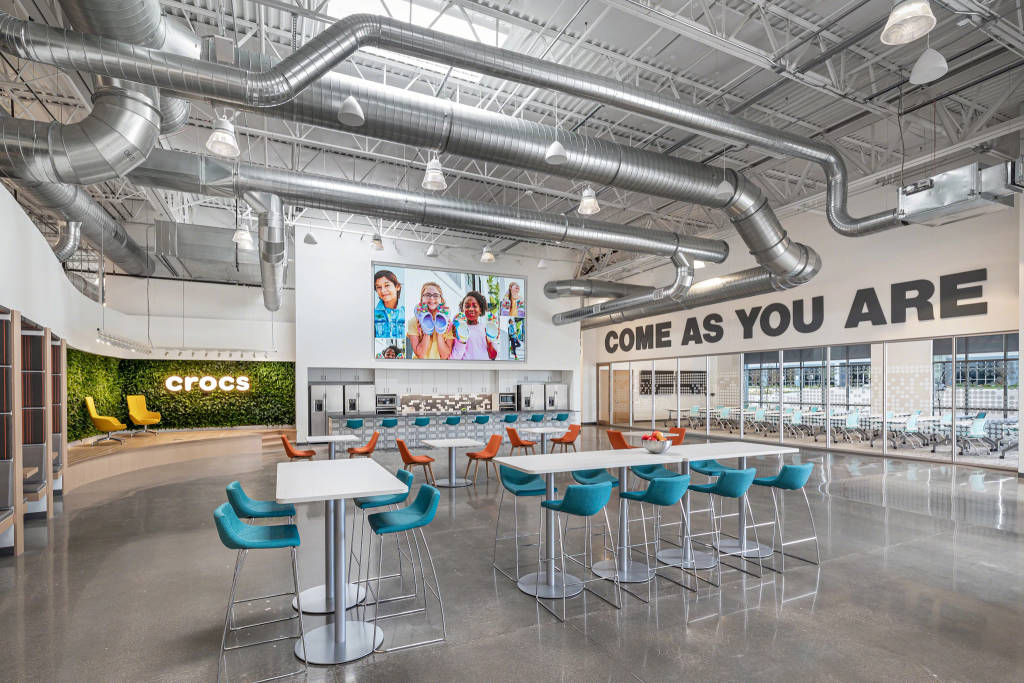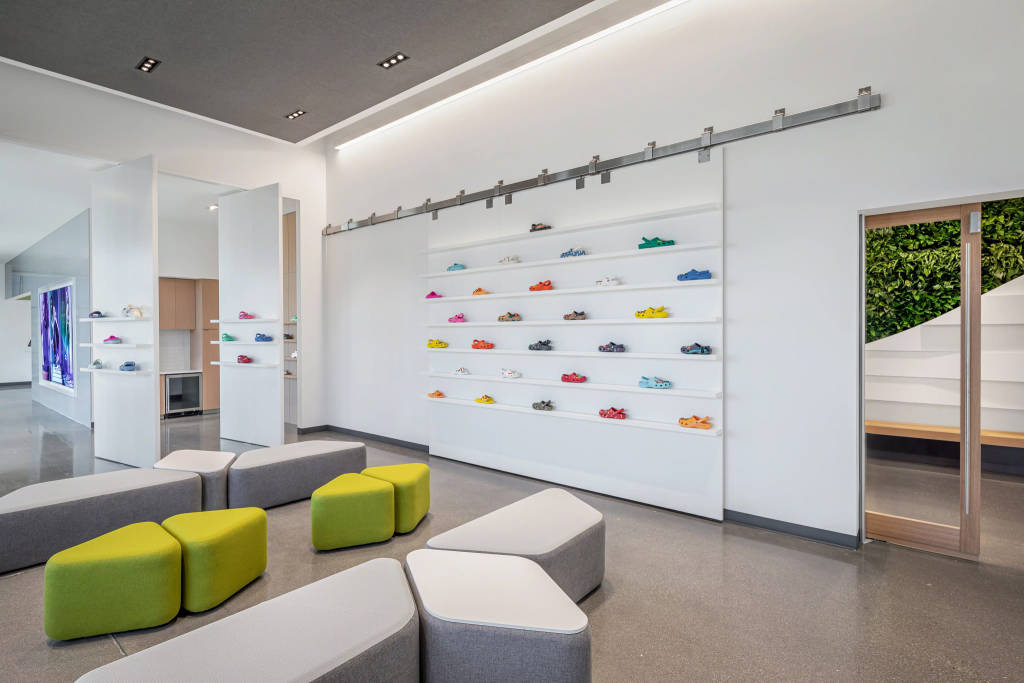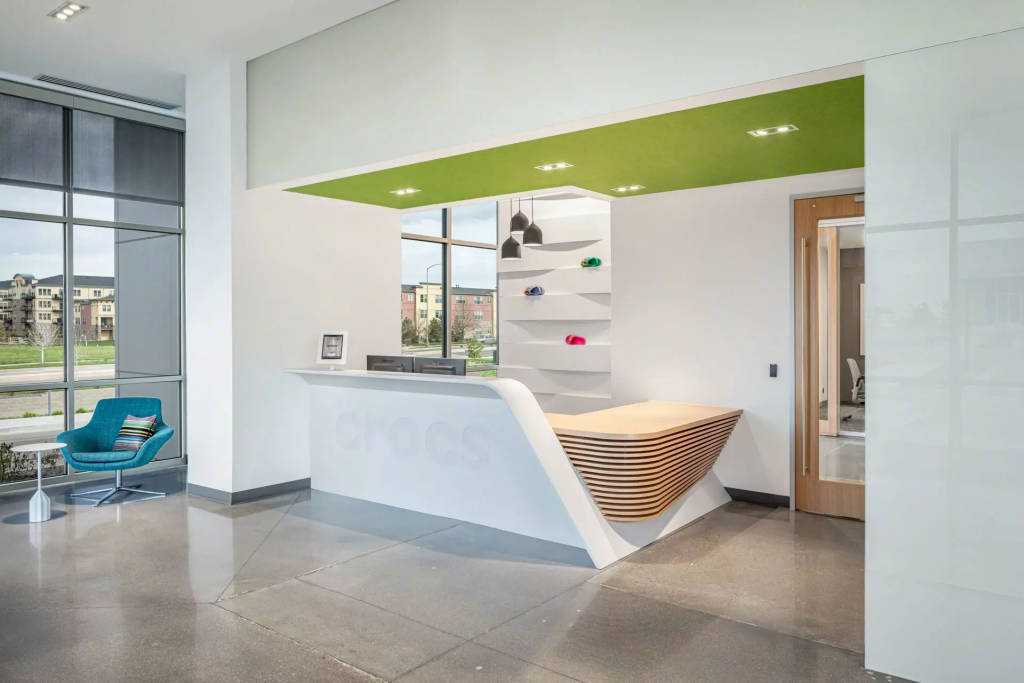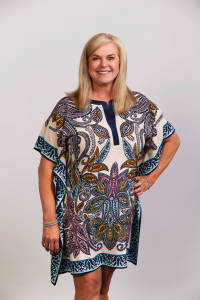Crocs: Helping Make Everyone Feel ‘Comfortable in Their Own Shoes’
Global footwear brand uses attractive, comfortable spaces to support a fulfilling workplace experience
Dr. Tracy Brower, vice president of Workplace Insights at Steelcase, spoke with Crocs’ Executive Vice President and Chief People Officer Shannon Sisler, to discuss how the progressive global footwear brand provides meaningful work experiences + balances employee flexibility with company need.

Tracy Brower: How do you think about the work experience and how have your thoughts about the work experience shifted over time?
Shannon Sisler: If you look at just three years ago, I think it’s evolved as people have reevaluated the office setting. “Do I come in or not?” is what people are asking themselves. I think you really need to consider as an organization how you can create a workplace experience that is going to be fulfilling, provide value and give people opportunities to collaborate. People communicate differently in person and virtually, so we’re focused on making sure that when people do come together, it’s a more meaningful experience. I think the other piece is that the work experience, in general, has evolved quite a bit as we’ve gone through the pandemic with such a tight labor market. If you’re not creating a work experience that’s fulfilling, you’re not going to attract and retain the talent that you need. We’ve made a lot of investments in our workplace the last few years, which was good going into a tough labor market and continues to serve us well. People’s experience in the office is definitely top of mind.
TB: How have your employees’ expectations shifted?
SS: One thing that’s a little different with Crocs is 75% of our workers are frontline jobs, either in retail stores or distribution centers. Frontline workers have continued to physically be on location day-in and day-out to serve our customers. We have really been focused on thinking about that population and how we create a reliably safe working environment. I think safety has taken a whole new definition in the last few years. It’s not just making sure that forklift drivers are operating correctly or the backroom is OK at the retail store, it’s also about making sure you have proper separation and proper hygiene protocols. Beyond that, the experience again has to be fulfilling. The great resignation is something a lot of HR leaders are talking about. I think if you’re not creating fulfilling work environments, you’re going to see a lot of turnover. That’s why we’ve been super focused on just making it fun and providing the right place for our workforce to come together.

TB: How do you create a sense of fairness and equity when you have so many employees who have to be there all the time, but then you’re giving flexibility to other employees?
SS: It’s something we’ve taken really seriously the last few years. One of the things we did was create workforce personas, align every role in the company to one of those four personas and figure out what percent of time each persona needs to be at the workplace. We also thought about whether that persona had an assigned desk and how much they travel. We’re being transparent about the expectations for those roles, both for people in existing roles and external candidates. It allows us to clearly say what the expectations are for each role. For example, I’m what we call a “collaborator.” As a leader, the expectation for my role is that I’m in the workplace 60 to 80% of the time. People in the role that we call our “residents,” are expected to be at work 90 to 100% of the time because they are front desk attendants or warehouse employees who serve our customers on a daily basis. It’s important to note that our personas are role based, not person based. So, a person in a similar job as me is not going to have a different persona because we look at the role and not the person. This system is something we put in place for everyone, not just office personnel. We then communicated it across the company and continuously manage and monitor it.
TB: What do you see as the future of HR as it supports the future of work?
SS: When I think about Human Resources, I think the future is a continued focus on what I call progressive people practices. It’s not about just managing personnel; it’s about putting in practices that help people thrive and confidently understand their role. It’s about making sure they receive feedback, continue to perform well and learn where they have opportunities to develop. It’s about having initiatives to support people’s wellness. It’s about creating a compelling employee value proposition. We’ve seen employee value propositions really shift over the last few years, and it’s not just about pay. It’s also about the environment that you’re creating and the benefits that you’re providing. The future is also about making sure your organization has an inclusive environment. We’re fortunate to have a very diverse and inclusive environment here at Crocs, which we take a lot of pride in.

TB: You mentioned that you had been making some investments in your space and in your work experience. Can you talk about what kinds of enhancements you’re making?
SS: We upgraded most of our corporate offices around the globe over the last five years to give them significant improvements, make them more attractive and give them more comfortable spaces. Our main mantra is “Come As You Are” and our vision is for everyone to be comfortable in their own shoes. We take comfort seriously – comfort on your feet and comfort in your work environment. We think a lot about what comfort looks like. To us, it means you have a good space where you can focus and collaborate – bright spaces, indoor spaces, outdoor spaces – places where you can truly thrive. Beyond that, we’ve spent a lot of effort making sure we have good branding in all the offices. We really want to bring our product and values to life through imagery on our walls and in our spaces so as people from around the world visit us, they know they’re at Crocs, wherever they are. I think that’s really important for creating culture and helping people know what they’re a part of and who they’re serving: our customers.
TB: How do you think about the connection conceptually between these issues: attraction, retention, comfort, inclusivity and place?
SS: To get the desired business outcomes, you have to create a space that people can thrive and feel comfortable in – virtually or in person.
As we’ve had this big war for talent over the last few years, it’s been important to stand out and create a place that people want to come to and be a part of the culture.
I think that is evidenced by the vibe you get from the moment you walk into our workplace. We want to make sure that the vibe you feel in the workplace reflects the culture you want to put out for the world to experience. It’s a direct line of sight into getting the right people in the right place, and that helps us deliver the desired results, which is our goal. I would add that we believe that in-person collaboration is critical to long-term success. Obviously we want to find flexibility where we can for our workforce, but we have to do the right thing for the business and for our people. While we continue to fine tune the right balance, we think that collaboration is critical to success.

Shannon Sisler, EVP, is the Chief People Officer for Crocs. She joined the organization in 2017 as the Senior Vice President and Chief People Officer. Sisler is responsible for human resources globally, including talent acquisition/development, employee relations, total rewards and corporate facilities. Prior to joining Crocs, Sislerheld HR leadership roles with Davita and Janus Capital and most recently served as Senior Vice President of Talent Management at Western Union where she was responsible for talent acquisition, leadership/professional development, talent management and workforce strategy.


